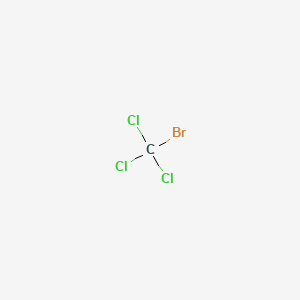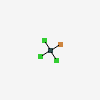Bromotrichloromethane
- BROMOTRICHLOROMETHANE
- 75-62-7
- Trichlorobromomethane
- Methane, bromotrichloro-
- bromo(trichloro)methane
- Create:2005-03-26
- Modify:2025-01-11

- Bromotrichloromethane
- Trichlorobromomethane
- BROMOTRICHLOROMETHANE
- 75-62-7
- Trichlorobromomethane
- Methane, bromotrichloro-
- bromo(trichloro)methane
- Carbon bromotrichloride
- Monobromotrichloromethane
- Carbon trichlorobromide
- Trichloromethyl bromide
- bromotrichloro methane
- Caswell No. 118
- CCl3Br
- CCRIS 2393
- HSDB 5208
- UNII-IKJ30QXM63
- NSC 8017
- EINECS 200-886-0
- IKJ30QXM63
- EPA Pesticide Chemical Code 008708
- BRN 1732543
- DTXSID7023930
- Bromo-trichloro-methane
- NSC-8017
- DTXCID003930
- 4-01-00-00077 (Beilstein Handbook Reference)
- BROMOTRICHLOROMETHANE [HSDB]
- CBrCl3
- CAS-75-62-7
- BrCCl3
- MFCD00000783
- bromo trichloromethane
- Methane, bromotrichloro
- WLN: GXGGE
- Halon 1031
- Bromotrichloromethane, 99%
- SCHEMBL109417
- CHEMBL160802
- NSC8017
- Tox21_202292
- Tox21_303534
- BR1357
- AKOS015833938
- NCGC00249206-01
- NCGC00257422-01
- NCGC00259841-01
- AS-57509
- B0662
- CS-0031583
- NS00020231
- E87219
- J-519951
- Q23780617
- Schoenflies notation
- Boiling point
- Chemical bond
- Density
- Diamagnetic susceptibility
- Dielectric constant
- Fusion temperature
- Heat of sublimation
- Internuclear distance
- Magnetic susceptibility
- Melting temperature
- Molecular structure
- Nuclear quadrupole resonance spectroscopy
- Optical coefficient
- Phase transition
- Point group
- Quadrupole coupling
- Refractive index
- Thermal expansion coefficient
- Transition enthalpy
- Vapor pressure
- Viscosity
119 99.99
117 99.03
47 42.90
163 39.39
82 36.38
119 999
117 990
47 429
163 394
82 364

H302 (98.5%): Harmful if swallowed [Warning Acute toxicity, oral]
H312 (31.9%): Harmful in contact with skin [Warning Acute toxicity, dermal]
H315 (71.9%): Causes skin irritation [Warning Skin corrosion/irritation]
H319 (71.9%): Causes serious eye irritation [Warning Serious eye damage/eye irritation]
H332 (28.9%): Harmful if inhaled [Warning Acute toxicity, inhalation]
P261, P264, P264+P265, P270, P271, P280, P301+P317, P302+P352, P304+P340, P305+P351+P338, P317, P321, P330, P332+P317, P337+P317, P362+P364, and P501
(The corresponding statement to each P-code can be found at the GHS Classification page.)
Aggregated GHS information provided per 135 reports by companies from 7 notifications to the ECHA C&L Inventory. Each notification may be associated with multiple companies.
Information may vary between notifications depending on impurities, additives, and other factors. The percentage value in parenthesis indicates the notified classification ratio from companies that provide hazard codes. Only hazard codes with percentage values above 10% are shown.
Acute Tox. 4 (98.5%)
Acute Tox. 4 (31.9%)
Skin Irrit. 2 (71.9%)
Eye Irrit. 2A (71.9%)
Acute Tox. 4 (28.9%)
Neurotoxin - Acute solvent syndrome
Occupational hepatotoxin - Secondary hepatotoxins: the potential for toxic effect in the occupational setting is based on cases of poisoning by human ingestion or animal experimentation.
Patents are available for this chemical structure:
https://patentscope.wipo.int/search/en/result.jsf?inchikey=XNNQFQFUQLJSQT-UHFFFAOYSA-N
- Australian Industrial Chemicals Introduction Scheme (AICIS)Methane, bromotrichloro-https://services.industrialchemicals.gov.au/search-inventory/
- CAS Common ChemistryLICENSEThe data from CAS Common Chemistry is provided under a CC-BY-NC 4.0 license, unless otherwise stated.https://creativecommons.org/licenses/by-nc/4.0/Bromotrichloromethanehttps://commonchemistry.cas.org/detail?cas_rn=75-62-7
- ChemIDplusBromotrichloromethanehttps://pubchem.ncbi.nlm.nih.gov/substance/?source=chemidplus&sourceid=0000075627ChemIDplus Chemical Information Classificationhttps://pubchem.ncbi.nlm.nih.gov/source/ChemIDplus
- DTP/NCILICENSEUnless otherwise indicated, all text within NCI products is free of copyright and may be reused without our permission. Credit the National Cancer Institute as the source.https://www.cancer.gov/policies/copyright-reuse
- EPA Chemicals under the TSCAMethane, bromotrichloro-https://www.epa.gov/chemicals-under-tscaEPA TSCA Classificationhttps://www.epa.gov/tsca-inventory
- EPA DSSToxBromotrichloromethanehttps://comptox.epa.gov/dashboard/DTXSID7023930CompTox Chemicals Dashboard Chemical Listshttps://comptox.epa.gov/dashboard/chemical-lists/
- EPA Integrated Risk Information System (IRIS)Bromotrichloromethanehttps://iris.epa.gov/ChemicalLanding/&substance_nmbr=533
- European Chemicals Agency (ECHA)LICENSEUse of the information, documents and data from the ECHA website is subject to the terms and conditions of this Legal Notice, and subject to other binding limitations provided for under applicable law, the information, documents and data made available on the ECHA website may be reproduced, distributed and/or used, totally or in part, for non-commercial purposes provided that ECHA is acknowledged as the source: "Source: European Chemicals Agency, http://echa.europa.eu/". Such acknowledgement must be included in each copy of the material. ECHA permits and encourages organisations and individuals to create links to the ECHA website under the following cumulative conditions: Links can only be made to webpages that provide a link to the Legal Notice page.https://echa.europa.eu/web/guest/legal-noticeBromotrichloromethanehttps://chem.echa.europa.eu/100.000.806Bromotrichloromethane (EC: 200-886-0)https://echa.europa.eu/information-on-chemicals/cl-inventory-database/-/discli/details/98437
- FDA Global Substance Registration System (GSRS)LICENSEUnless otherwise noted, the contents of the FDA website (www.fda.gov), both text and graphics, are not copyrighted. They are in the public domain and may be republished, reprinted and otherwise used freely by anyone without the need to obtain permission from FDA. Credit to the U.S. Food and Drug Administration as the source is appreciated but not required.https://www.fda.gov/about-fda/about-website/website-policies#linkingBROMOTRICHLOROMETHANEhttps://gsrs.ncats.nih.gov/ginas/app/beta/substances/IKJ30QXM63
- Hazardous Substances Data Bank (HSDB)BROMOTRICHLOROMETHANEhttps://pubchem.ncbi.nlm.nih.gov/source/hsdb/5208
- New Zealand Environmental Protection Authority (EPA)LICENSEThis work is licensed under the Creative Commons Attribution-ShareAlike 4.0 International licence.https://www.epa.govt.nz/about-this-site/general-copyright-statement/
- Risk Assessment Information System (RAIS)LICENSEThis work has been sponsored by the U.S. Department of Energy (DOE), Office of Environmental Management, Oak Ridge Operations (ORO) Office through a joint collaboration between United Cleanup Oak Ridge LLC (UCOR), Oak Ridge National Laboratory (ORNL), and The University of Tennessee, Ecology and Evolutionary Biology, The Institute for Environmental Modeling (TIEM). All rights reserved.https://rais.ornl.gov/Bromotrichloromethanehttps://rais.ornl.gov/cgi-bin/tools/TOX_search
- ChEMBLLICENSEAccess to the web interface of ChEMBL is made under the EBI's Terms of Use (http://www.ebi.ac.uk/Information/termsofuse.html). The ChEMBL data is made available on a Creative Commons Attribution-Share Alike 3.0 Unported License (http://creativecommons.org/licenses/by-sa/3.0/).http://www.ebi.ac.uk/Information/termsofuse.html
- Comparative Toxicogenomics Database (CTD)LICENSEIt is to be used only for research and educational purposes. Any reproduction or use for commercial purpose is prohibited without the prior express written permission of NC State University.http://ctdbase.org/about/legal.jspBromotrichloromethanehttps://ctdbase.org/detail.go?type=chem&acc=D001975
- Haz-Map, Information on Hazardous Chemicals and Occupational DiseasesLICENSECopyright (c) 2022 Haz-Map(R). All rights reserved. Unless otherwise indicated, all materials from Haz-Map are copyrighted by Haz-Map(R). No part of these materials, either text or image may be used for any purpose other than for personal use. Therefore, reproduction, modification, storage in a retrieval system or retransmission, in any form or by any means, electronic, mechanical or otherwise, for reasons other than personal use, is strictly prohibited without prior written permission.https://haz-map.com/AboutBromotrichloromethanehttps://haz-map.com/Agents/4010
- MassBank EuropeBROMOTRICHLOROMETHANEhttps://massbank.eu/MassBank/Result.jsp?inchikey=XNNQFQFUQLJSQT-UHFFFAOYSA-N
- Japan Chemical Substance Dictionary (Nikkaji)
- MassBank of North America (MoNA)LICENSEThe content of the MoNA database is licensed under CC BY 4.0.https://mona.fiehnlab.ucdavis.edu/documentation/license
- NIST Mass Spectrometry Data CenterLICENSEData covered by the Standard Reference Data Act of 1968 as amended.https://www.nist.gov/srd/public-lawMethane, bromotrichloro-http://www.nist.gov/srd/nist1a.cfm
- SpectraBaseMETHANE, BROMOTRICHLORO-https://spectrabase.com/spectrum/C9Hev4NbYUXBromotrichloromethanehttps://spectrabase.com/spectrum/Aii9lTDeqBromotrichloromethanehttps://spectrabase.com/spectrum/BHqkwpDwhW0Bromotrichloromethanehttps://spectrabase.com/spectrum/Fzcr5jvRnVsBROMOTRICHLOROMETHANEhttps://spectrabase.com/spectrum/6mL25X5517PBromotrichloromethanehttps://spectrabase.com/spectrum/GEjksBqi1pWBROMOTRICHLOROMETHANEhttps://spectrabase.com/spectrum/EiHPl1mOw1xBromotrichloromethanehttps://spectrabase.com/spectrum/93viMw8En9xBROMOTRICHLOROMETHANEhttps://spectrabase.com/spectrum/67yig4WsTAeBROMOTRICHLOROMETHANEhttps://spectrabase.com/spectrum/AlXck7s4C3E
- Springer Nature
- SpringerMaterialsbromo-trichloro-methanehttps://materials.springer.com/substanceprofile/docs/smsid_mqbrzhwutmmltpkb
- Thieme ChemistryLICENSEThe Thieme Chemistry contribution within PubChem is provided under a CC-BY-NC-ND 4.0 license, unless otherwise stated.https://creativecommons.org/licenses/by-nc-nd/4.0/
- Wikidatabromotrichloromethanehttps://www.wikidata.org/wiki/Q23780617
- Medical Subject Headings (MeSH)LICENSEWorks produced by the U.S. government are not subject to copyright protection in the United States. Any such works found on National Library of Medicine (NLM) Web sites may be freely used or reproduced without permission in the U.S.https://www.nlm.nih.gov/copyright.htmlBromotrichloromethanehttps://www.ncbi.nlm.nih.gov/mesh/68001975
- PubChem
- GHS Classification (UNECE)GHS Classification Treehttp://www.unece.org/trans/danger/publi/ghs/ghs_welcome_e.html
- NORMAN Suspect List ExchangeLICENSEData: CC-BY 4.0; Code (hosted by ECI, LCSB): Artistic-2.0https://creativecommons.org/licenses/by/4.0/NORMAN Suspect List Exchange Classificationhttps://www.norman-network.com/nds/SLE/
- EPA Substance Registry ServicesEPA SRS List Classificationhttps://sor.epa.gov/sor_internet/registry/substreg/LandingPage.do
- MolGenieMolGenie Organic Chemistry Ontologyhttps://github.com/MolGenie/ontology/
- PATENTSCOPE (WIPO)SID 403393143https://pubchem.ncbi.nlm.nih.gov/substance/403393143



